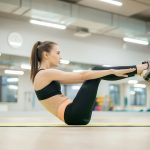Aqua Aerobics at Home: Splash Into Low-Impact Fitness
Water Walking and Jogging
Water walking and jogging offer a low-impact alternative to traditional land-based workouts, benefiting those with joint sensitivities or injuries. The buoyancy of water alleviates pressure on joints, while the resistance builds muscle strength and improves cardiovascular fitness. Participants engage core and leg muscles when moving through water, enhancing balance and coordination.
Depending on the depth, this exercise can target different muscle groups: walking in shallow water emphasizes leg muscles, while deep-water movements engage the core more. Incorporating varied speeds and directions can further intensify the workout, making it suitable for diverse fitness levels.
Jumping Jacks and Leg Lifts
Jumping jacks and leg lifts in water amplify the benefits of these traditional exercises by introducing water resistance. When performing jumping jacks, individuals jump with legs spreading apart while simultaneously bringing their arms from the sides upwards. Water resistance increases the effort required, thereby strengthening the core, legs, and arms.
Leg lifts focus on enhancing core stability and leg strength. Standing in water, one raises and lowers each leg in controlled motions, either front-to-back or side-to-side. These exercises not only tone muscles but also improve balance and coordination. Practicing in water reduces stress on joints and promotes flexibility, making it ideal for all fitness levels.
Advanced Water Workouts
Advanced water workouts push fitness levels with exercises focused on improving strength and cardiovascular health. These routines use water’s natural resistance and can incorporate various tools to enhance efforts.
Incorporating Resistance Training
Resistance training in water leverages the force exerted by the water itself, providing a challenging yet joint-friendly workout. Participants can utilize tools such as aquatic dumbbells or resistance bands to intensify their exercise routines.
The focus lies on controlled movements, which can help build muscle and improve endurance. Employing equipment can simulate land-based weight training in a buoyant environment, reducing the risk of injury while promoting balanced fitness. Fitness classes featuring this style of training offer structured environments with guided sessions, ensuring participants maximize their physical benefits. Such training can help in improving flexibility, stability, and overall muscular balance.
High-Intensity Water Routines
High-intensity water routines are designed for those seeking to elevate their heart rate while enjoying the benefits of water exercise. These workouts often mix aerobic movements with periods of intense exertion to provide a comprehensive cardiovascular challenge.
Such sessions might involve jumping jacks, sprints across the pool, or rapid water jogging. Fitness classes offering high-intensity routines allow for a communal and spirited environment, motivating participants to push their limits. By utilizing the water’s resistance, these workouts can enhance calorie burn and cardiovascular endurance without the high impact of traditional land workouts. Water’s buoyancy provides support, minimizing strain on the body while stimulating muscle and heart performance.
Designing Your Workout Plan
A well-structured aqua aerobics workout plan involves setting specific fitness goals and creating a balanced routine. This ensures that individuals can optimize their efforts and progressively work towards gaining or maintaining fitness levels while enjoying low-impact exercise.
Setting Fitness Goals
Defining clear fitness goals is crucial. These goals might include improving cardiovascular health, building muscle strength, or aiding weight loss. It’s vital to determine a realistic pace for achieving these objectives, tailored to personal needs and abilities.
For those focusing on weight loss, setting a weekly target can be beneficial. This offers structure and motivation. Goals must be adaptable, allowing for adjustments based on progress and any lifestyle changes. Tracking progress helps in maintaining motivation and identifying any areas requiring more attention or alteration.
Creating a Balanced Routine
A well-rounded aqua aerobics routine combines various exercises that target different muscle groups while maintaining a consistent pace. This balance not only enhances fitness levels but also prevents overuse injuries.
Incorporating a mix of cardiovascular activities, strength-building exercises, and flexibility movements keeps the regime engaging. Sessions could start with a warm-up, followed by cardio like jogging or jumping, and strength work with water dumbbells. Cool downs with stretching exercises are essential to relax muscles post-workout. Diversifying sessions helps maintain interest and ensures all fitness areas are addressed.



